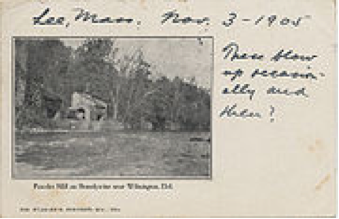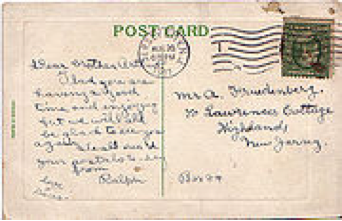Picture Post Cards
A postcard or post card is a rectangular piece of thick paper intended for writing and mailing without an envelope. It may be mailed at a lower postal rate than a letter. Stamp collectors distinguish between post cards (which require a stamp) and postal cards (which have the postage pre-printed on them). The United States Postal Service began issuing pre-stamped postal cards in 1873. The early postal cards were mainly used by businesses to mail commercial ads to their customers. The public thought it improper to mail messages that anyone could read, including the mail man and the house servants. The USPS was the only establishment allowed to print post cards, and it held its monopoly until May 19, 1898, when Congress passed the Private Mailing Card Act which allowed private publishers and printers to produce post cards.
The first picture “Post Card” in the United States was created in 1893 with views of buildings at the World's Columbian Exposition in Chicago. Writing was allowed only on the picture side of these cards while the back was reserved for the address. Shortly thereafter, the United States Postal Service allowed printers to publish a 1-cent postcard (the "Penny Postcard").
The "divided back" card, with space for a message on the address side, came into use in the United States in 1907. The back is divided into two sections; the left section being used for the message and the right for the address. The first decade of the 20th century is considered the "Golden Age" of picture postcards.

Front of a 1905 card

Divided Back Americans went wild for picture postcards and collecting these vignettes of life was a grand hobby. The study and collecting of postcards is termed deltiology. Although some picture post cards depicting America were printed in the United States, the majority of postcards sold in America were printed in Germany where lithography was an art. Besides colored lithography, many postcards were produced as photos directly from negatives. These are referred to as "Real Photo" cards. Unlike their more colorful lithographic cousins, real photo cards were originally produced in black and white or sepia tones. The current postcard era, which began about 1939, is the "chrome" era. The images on these cards are generally based on colored photographs, and are readily identified by the glossy appearance given by the paper's coating.
After the First World War more and more Americans bought automobiles and took to the highways in search of adventure and to explore our country’s scenery. This is when gas stations, restaurants, tourist cabins, and roadside attractions started to give away picture post cards for promotion or as souvenirs. Every city and town located along major highways made sure that pictures of their prominent buildings and parks were available on the front of postcards. Many enlarged post card pictures of Poland, Ohio, in the 1920s and 1930s can now be seen on the walls of Poland’s Friendlys Restaurant.
Youngstown’s Idora Amusement Park has been demolished, but today one can still relive the fun of riding the “Old Mill,” the “Wild Cat” and the “Jack Rabbit” by looking at old picture postcards. Each card’s message reads, “Wish you were here.”
